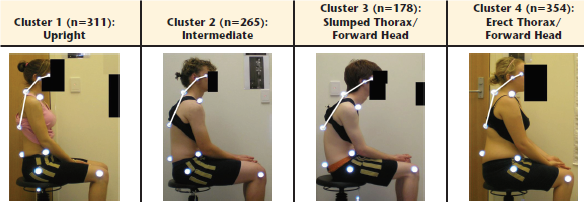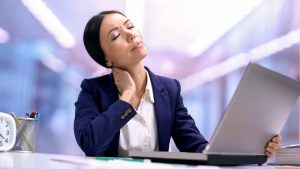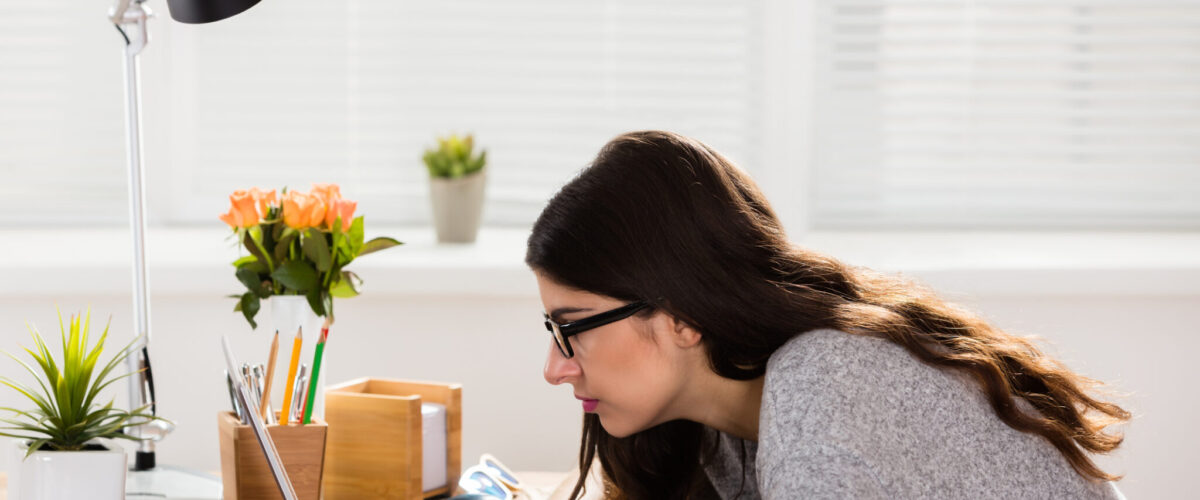“I’VE GOT TERRIBLE POSTURE”: HOW TO IMPROVE SHOULDER AND NECK PAIN
Key Points Related To Posture and Neck Pain
- Despite the overwhelming assumption in Australian society that posture is related to neck pain, research studies are conflicting suggesting it may not have as great a link as we thought.
- Some studies have found an association between forward head posture and pain, whereas other studies have found no association (1). In addition, no research shown has found a link to demonstrate forward head posture and headache symptoms.

A large group of 17 year old Australian adolescents, some with and without neck pain, were assessed for their sitting posture and its relationship with neck pain, lifestyle factors as well as psychosocial factors (2).
- None of the 4 types of sitting postures as seen above were associated with persistent neck pain or neck pain made worse by sitting.
- Those seen in Cluster 3 (picture above) with slumped thorax and forward head posture had higher likelihood of depression symptoms. The Cluster 3 posture was shown in another study to be linked with anxiety and depression symptoms. The authors suggest this finding could support the concept of a “mind-body relationship”.
- The more upright Cluster 1 posture participants were more physically active compared to the other cluster groups. This agrees with previous research showing that physical activity is related to greater back muscle endurance.
- Females displayed more upright sitting postures than males and the reason for this is unknown.
- Main findings suggested that in adolescents it is common to develop a ‘forward head posture’ – with their head positioned forward of their trunk when sitting (as seem in the study picture above; Richards et al, 2016)
- A higher Body Mass Index (weight (kgs)/height (m2)) was associated with a more slumped posture.

2 Other Key Studies:
- A study looking at 958 people without any neck injury or symptoms were assessed for their neck posture; specifically the cervical spine – which connects our mid-back (thoracic spine) to our head (3).
- The term kyphosis of the neck is a more scientific way of what some can consider as ‘poor neck posture’ or also known as ‘forward head posture’ and ’round-back’.
- 42% of these people without neck symptoms had one of 2 forms of kyphotic cervical posture suggesting that in middle-aged people that posture does not necessarily mean someone will experience neck symptoms.
- Another study looked at the forward head posture and neck muscle endurance of 16-18 year old adolescents. 35 adolescents with neck pain (for at least once per week in the previous 3 months) and 35 adolescents without neck pain were assessed (4).
- Adolescents with neck pain showed less neck muscle (flexor and extensor) endurance capacity than those without neck pain.
- This suggests that the endurance capacity of the muscles may be more relevant to the development of neck symptoms rather than posture in adolescents.

So If Posture May Not Cause Neck Pain, Can I Slump All Day?
- Specific types of postures may not be linked with neck pain however research has clearly shown in those with longstanding neck pain that the timing and activation of muscles around the neck and shoulder region are affected.
- A study examined for differences between Australian female office workers with mild pain, moderate, no pain and another group of females that were not office workers (5).
- Main findings revealed; the group with most pain ‘moderate pain’ had the least rotation range of motion at the neck i.e. their range of motion to turn the head to the left or to the right was less. The next least group was the ‘mild pain’ group and interestingly female office workers with no pain had less rotation range of motion than those who did not work in an office.
- When aiming to ‘activate’ the important deep flexor muscles (at the front of the neck) which are important for the support of cervical (neck) joints and posture; those with mild and moderate neck pain had higher activity levels of the more ‘superficial’ muscles suggesting their deeper flexor muscles were less proficient in supporting the cervical joints.
- When participants were asked to raise one arm up; office workers with pain showed greater muscle activity of the more superficial neck/shoulder muscles than those without pain and the non office-workers. This suggests the muscles (cervical extensors) were potentially ‘working harder’ to help stabilise the head when raising the arm and potentially a learned ‘muscle guarding’ response (upper trapezius, sternocleidomastoid and anterior scalenes) to protect against movement and pain.
- The importance of endurance and stabilisation of the neck muscles, to support the head in order to minimise neck pain, should potentially be more of the focus than the resting posture itself.
Below is 2 simple exercises you can aim to perform to help improve the activation of the shoulder and neck muscles
| 1. Martinez-Merinero, P., Nuñez-Nagy, S., Achalandabaso-Ochoa, A., Fernandez-Matias, R., Pecos-Martin, D., & Gallego-Izquierdo, T. (2020). Relationship between Forward Head Posture and Tissue Mechanosensitivity: A Cross-Sectional Study. Journal of Clinical Medicine, 9(3), 634.2. Richards, K. V., Beales, D. J., Smith, A. J., O’Sullivan, P. B., & Straker, L. M. (2016). Neck posture clusters and their association with biopsychosocial factors and neck pain in Australian adolescents.3. Kim, S. W., Kim, T. H., Jang, C., Yang, M. H., Lee, S., Yoo, J. H., … & Oh, J. K. (2018). Analysis of cervical spine alignment in currently asymptomatic individuals: prevalence of kyphotic posture and its relationship with other spinopelvic parameters. The Spine Journal, 18(5), 797-810.4. Oliveira, A. C., & Silva, A. G. (2016). Neck muscle endurance and head posture: a comparison between adolescents with and without neck pain. Manual therapy, 22, 62-67.5. Johnston, V., Jull, G., Souvlis, T., & Jimmieson, N. L. (2008). Neck movement and muscle activity characteristics in female office workers with neck pain. Spine, 33(5), 555-563. |


